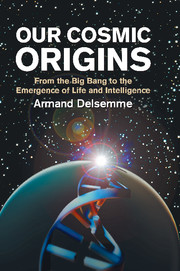Book contents
- Frontmatter
- Contents
- Foreword
- Preface
- Acknowledgments
- 1 Locating humans in the Universe
- 2 The race toward complexity
- 3 The stellar alchemy of metals
- 4 The formation of the planets
- 5 The emergence of life
- 6 The history of life
- 7 The awakening of intelligence
- 8 The other worlds
- 9 Perspectives
- APPENDIX A The standard model of the physics of elementary particles
- APPENDIX B Symmetry in physics
- APPENDIX C The strange role of time in relativity
- APPENDIX D The measurement of long time spans and the age of the Universe
- APPENDIX E The standard model of the Big Bang
- APPENDIX F The cause of the Big Bang and inflation
- APPENDIX G Chirality
- Glossary
- Bibliography
- Figure index
- Table index
- Name index
- Subject index
APPENDIX G - Chirality
Published online by Cambridge University Press: 05 August 2012
- Frontmatter
- Contents
- Foreword
- Preface
- Acknowledgments
- 1 Locating humans in the Universe
- 2 The race toward complexity
- 3 The stellar alchemy of metals
- 4 The formation of the planets
- 5 The emergence of life
- 6 The history of life
- 7 The awakening of intelligence
- 8 The other worlds
- 9 Perspectives
- APPENDIX A The standard model of the physics of elementary particles
- APPENDIX B Symmetry in physics
- APPENDIX C The strange role of time in relativity
- APPENDIX D The measurement of long time spans and the age of the Universe
- APPENDIX E The standard model of the Big Bang
- APPENDIX F The cause of the Big Bang and inflation
- APPENDIX G Chirality
- Glossary
- Bibliography
- Figure index
- Table index
- Name index
- Subject index
Summary
Chirality is the property of those molecules that can exist into two symmetrical forms corresponding to mirror reflections, but cannot be superimposed on each other by a mere rotation in space. Left-hand and right-hand gloves are an example of chirality. Chiral objects must be three-dimensional, since two symmetrical plane objects can always be superimposed by a reversal in space.
Many of the molecules used by life are chiral. However, when they exist in non-living matter, most of the time one half is in the right-hand form and the other half is in the left-hand form. This is what is called a racemic mixture. In contrast, life nearly always chooses only one of these two forms. For instance, all proteins consist of left-hand amino acids, whereas RNA and DNA are always built up from right-handed sugars. When a living organism dies and decays, thermal fluctuations change molecular shapes at random, so that, in the long run, there is racemization. Since the opposite process does not exist, a mechanism was needed to trigger the emergence of life by selecting preferentially one of the two chiral forms. The continuity of life then becomes only a mere copying process.
Was the choice random? Two forms of life of different chirality could have emerged. Left-handed proteins could have eliminated righthanded proteins by a random evolutionary process. This matter does not seem fundamental for elucidating the origins of life, because all biochemical processes depend on chemistry; that is, on the electromagnetic interaction which is mirror-symmetric.
- Type
- Chapter
- Information
- Our Cosmic OriginsFrom the Big Bang to the Emergence of Life and Intelligence, pp. 295 - 296Publisher: Cambridge University PressPrint publication year: 1998



